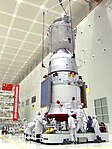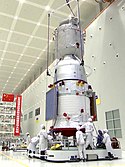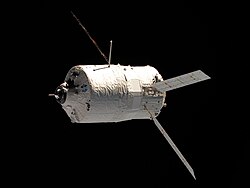Servicemodul

En servicemodul är en komponent i en bemannad rymdfarkost som innehåller en mängd olika stödsystem för farkosten. Den är oftast placerad i de obebodda delarna av rymdfarkosten, bakom besättningens kapsel. I servicemodulen förvaras flera kritiska delsystem, så som elektriska system, miljökontroll, drivmedelstankar och system för framdrift, liknande funktionen hos en satellitplattform.
Servicemodulen kastas bort när uppdraget är klart och brinner vanligtvis upp vid återinträde i atmosfären.[1]
Beroende på rymdfarkostens arkitektur och systemdesign kan innehållet i servicemodulen variera. Nedan listas vanligt förekommande system i servicemodulen: [1] [2]
- Bränsleceller, solpaneler eller batterier för att försörja rymdfarkosten med elektricitet. Batterier brukar även finnas i besättningens kapsel.
- Flytande väte (LH2) och flytande syre (LOX) för bränslecellsdrift och vattenproduktion, där LOX också används för att ge andningssyre till besättningen.
- Trycksatt helium eller kväve för att trycka förbrukningsvaror och bränsle från källtankar till sina destinationer.
- Navigationsdatorer och tillhörande sensorer.
- Bränsle och oxidationsmedel till styrraketer och framdrivningssystem.
- Termiska styrsystem för uppvärmning och kylning av ovanstående system.
Servicemodulen kan även innehålla vetenskapliga instrument, filmkameror och annat som kan behövas under uppdraget. Servicemodulen kan även användas för att släppa mindre rymdsonder och kubsatelliter under färden.
Även rymdstationer bestående av flera moduler har dedikerade servicemoduler.
Galleri
- Apollo med servicemodul
- Ryska Zvezda modulen (ISS)
- Sojuz med servicemodul
- ATV med servicemodul
- Orions servicemodul
- Shenzhou med servicemodul
- Mars Pathfinder med servicemodul
- X-37B med servicemodul
Referenser
- Den här artikeln är helt eller delvis baserad på material från engelskspråkiga Wikipedia, Service module, 19 juli 2023.
- ^ [a b] ”CSM07 Service Module Overview” (på engelska) (PDF). NASA. https://history.nasa.gov/alsj/CSM07_Service_Module_Overview_pp53-60.pdf. Läst 19 juli 2023.
- ^ NASA Administrator (6 juni 2013). ”Explore the Exploration Vehicle” (på engelska). NASA. Arkiverad från originalet den 17 december 2011. https://web.archive.org/web/20111217070953/http://www.nasa.gov/exploration/systems/mpcv/explore.html. Läst 19 juli 2023.
Media som används på denna webbplats
orion sevice module (SM)
The Apollo 15 Service Module as viewed from the Apollo Lunar Module. Image has been cropped and rotated.
Författare/Upphovsman: Roryjoem, Licens: CC BY-SA 3.0
A simple diagram of the Vostok spacecraft.
X-37B Orbital Test Vehicle concludes its sixth successful mission.
KENNEDY SPACE CENTER, Fla. -- The X-37B Orbital Test Vehicle-6 (OTV-6), the U.S. Space Force’s unmanned, reusable spaceplane, successfully deorbited and landed at NASA’s Kennedy Space Center Shuttle Landing Facility on Nov. 12, 2022, at 05:22 a.m.
OTV -6 was the first mission to introduce a service module-a ring attached to the rear of the vehicle expanding the number of experiments that can be hosted during a mission. “This mission highlights the Space Force's focus on collaboration in space exploration and expanding low-cost access to space for our partners, within and outside of the Department of the Air Force (DAF),” said Gen. Chance Saltzman, Chief of Space Operations.
The service module successfully separated from the OTV before landing, which is a necessary activity due to the aerodynamic forces experienced by the X-37B vehicle upon re-entry. In the coming weeks, the service module will be disposed of in accordance with best practices. Secretary of the Air Force Frank Kendall said, “The deliberate manner in which we conduct onorbit operations-to include the service module disposal-speaks to the United States' commitment to safe and responsible space practices, particularly as the issue of growing orbital debris threatens to impact global space operations.”
The OTV-6 mission hosted the Naval Research Laboratory's Photovoltaic Radiofrequency Antenna Module. This experiment successfully harnessed solar rays outside of Earth's atmosphere and aimed to transmit power to the ground in the form of radio frequency microwave energy. Additionally, the U.S. Air Force Academy's FalconSat-8, developed in partnership with Air Force Research Laboratory, was successfully deployed in October 2021. FalconSat-8 remains in orbit, providing Academy cadets unique hands-on experience as space operators prior to entering active duty.
Multiple NASA experiments were deployed on OTV-6. The Materials Exposure and Technology Innovation in Space (METIS-2) included thermal control coatings, printed electronic materials, and candidate radiation shielding materials. METIS-1-which flew on OTV-5-consisted of similar sample plates mounted on the flight vehicle. NASA scientists will leverage data collected after the materials have spent 900+ days in orbit and compare observed effects to ground simulations, validating and improving the precision of space environment models.
Another NASA experiment aims to investigate the effect of long-duration space exposure on seeds. Scientists are interested in the seeds’ resistance and susceptibility to space environment-unique stresses, notably radiation. The seeds experiment will inform space crop production for future interplanetary missions and the establishment of permanently inhabited bases in space.
“The X-37B continues to push the boundaries of experimentation, enabled by an elite government and industry team behind the scenes,” said Lt. Col. Joseph Fritschen, DAF Rapid Capabilities Office’s X-37B Program Director. “The ability to conduct on-orbit experiments and bring them home safely for in-depth analysis on the ground has proven valuable for the Department of the Air Force and scientific community. The addition of the service module on OTV-6 allowed us to host more experiments than ever before.”
The sixth mission conducted on-orbit experiments for 908 days.

|
Denna bild släpptes av Förenta staternas Air Force med ID 221111-F-XX000-0004 (nästa).
|
Views of the nadir side of the International Space Station (ISS) taken during Endeavour's, Orbital Vehicle 105 (OV-105), initial approach by the STS-97 crewmembers.
Pathfinder framme vid Mars
(c) China News Service, CC BY 3.0
Shenzhou spacecraft being assembled
Författare/Upphovsman: CactiStaccingCrane, Licens: CC0
This picture is retouched from the original by cropping, denoising, rotating, etc. Though the flickr's source page licensed the image with non-commercial license, it is a work by NASA astronaut in duty and therefore, in public domain.
Original caption:
- The Soyuz spacecraft carrying NASA astronaut Chris Cassidy and Expedition 63 crewmates Anatoly Ivanishin and Ivan Vagner, of the Russian space agency Roscosmos, leaves the International Space Station at 7:32 p.m. EDT Oct. 21, 2020, to return to Earth after the crew’s 196-day mission.
- The Soyuz MS-16 crew ship, with Expedition 63 crewmates Chris Cassidy of NASA and Roscosmos cosmonauts Anatoly Ivanishin and Ivan Vagner, departs the International Space Station moments after undocking from the Rassvet module. The trio would parachute to Earth inside the Soyuz' descent module just a few hours later.
ISS026-E-037172 (24 Feb. 2011) --- Surrounded by the blackness of space, the European Space Agency's "Johannes Kepler" Automated Transfer Vehicle-2 (ATV-2) approaches the International Space Station. Docking of the two spacecraft occurred at 10:59 a.m. (EST) on Feb. 24, 2011.
















